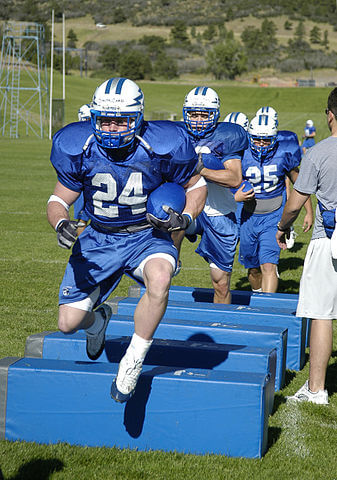As August comes around the bend it's time for another action packed fall sports season and the only thing more inevitable than that fresh crisp autumn air is the rash of sports related injuries that occur.
Today I'll give you my top five ways to stay on the field and court this fall.
1) Learn to listen
As athletes we are a competitive bunch and it can be really difficult to turn it down when we probably should. Unfortunately we are not men of steel and our bodies remind us of this all the time. There is a difference between being tough and being smart. As an athlete you need to be both.
The signals are there you just need to listen. Always remember, fatigue masks performance. If you are less than recovered in any way your overall potential will not shine through. There are times to gut it out and push through, but that doesn't mean you must do it every day. Train and practice hard but don't do it for the sake of beating yourself up. If your knee is achy take note, if your back is sore listen up, if you feel drained don't ignore it. The most important games are at the end of the season; make sure you are on the field to see them.
2) Make refueling a priority
Calories = energy. Without quality sources of calories our energy levels suffer drastically and so does our performance. It does not matter if you are 13 or 30 without quality fuel performance, endurance and fatigue resistance significantly suffers. It is up to you to make proper refueling a top priority.
Refueling begins with proper hydration. Although water does not contain any calories staying hydrated is critical for all health, recovery and performance. In fact, water loses of just 2% of total bodyweight have shown to directly relate to a significant drop-offs in performance. Most athletes pay close attention to hydration during practices and games but have poor awareness the rest of the time. Water is the best way to stay hydrated, drink a lot and drink it often.
Eat like there is a purpose because there needs to be. If you are waiting four hours after practice until you eat something then you are doing yourself a serious disservice. Refueling does not occur without the fuel source. The more active the athlete the higher the caloric demands. As an athlete you should know the difference between a carbohydrate, protein and fat. What good choices are and when is the best time to consume them. Yes, this might take a little homework on your part but if you aren't willing to help yourself then you aren't going to make it to the next level anyway.
3) Rest easy
A large part of the recovery process occurs during sleep. Without adequate amounts of quality sleep complete recovery is impossible. Research has suggested sleep deprivation increases fatigue, negatively affects energy levels and leads to poor focus during competition. Rules for quality sleep go like so:
- Go to bed near the same time every night
- Eliminate as much light in the room as possible
- No caffeine after dinner
- Plan on 7-8 hours every night
- Get in bed before midnight
4) The weight room is still open for business
A critical mistake I witness way to often is the disappearance of foot traffic in high school weight rooms during the season. Do yourself a huge favor and do not stop lifting in-season. It is almost unanimously agreed upon that building strength is a great way to prevent injuries through the season, but this only works if you stay strong during the season.
There are a few simple rules to follow during in-season strength training:
- Cut training frequency. This means if you were training 4-times per week in the off-season you will likely only need to train twice per week to maintain the majority of your strength in-season.
- Reduce overall training volume. This will automatically come just by reducing training frequency but another way to do this is reduce the number of sets and reps. Stick to 2-3 sets of lower rep brackets with higher weights.
- Eliminate extra conditioning sessions. The purpose of off-season conditioning should be to prepare you to face the exact metabolic demands of a specific sport. If you are in-season then you are facing those conditions almost every day to some degree.
5)Mobility is a must
Mobility is a must and in-season athletes tend to lose quite a bit of it from accumulated fatigue and poor recovery. Stiff muscles decrease our flexibility and active range of motion making us much more prone to muscle strains and other soft tissue injuries. When mobility is lost so is movement efficiency, this means the energy costs of a given task increase which means we run out of gas sooner. In addition once mobility is lost technique and mechanics suffer. These mechanical breakdowns lead to compensatory movements of parts of the body that shouldn't be moving and are the major cause of energy leaks and overuse injuries. Mobility work should always be a priority especially in-season. Some mobility and flexibility work should be done everyday in-season.
If you don't have your own personal foam roller by now please get one today. Here is the direct link to the ones we use. They're cheap, they last and portable.
You will never be unbreakable but you should be hard to break. Adopt these habits this season and stay on the field and off the trainer's table.
"AmericanFootballTraining". Licensed under Public domain via Wikimedia Commons - http://commons.wikimedia.org/wiki/File:AmericanFootballTraining.jpg#mediaviewer/File:AmericanFootballTraining.jpg


